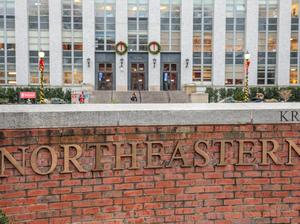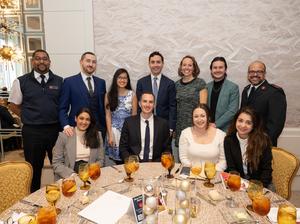
For some people, communicating with others involves listening to their spoken words, reading a text message or browsing a newspaper. But for DeafBlind individuals (people who are concurrently deaf and blind), it can be difficult to communicate without an interpreter.
Boston-based Tatum Robotics is one of the first companies working on new, innovative technologies for the DeafBlind community. The startup is developing tactile sign language robots. Tatum Robotics recently received $255,000 in SBIR funding from the National Science Foundation to further its communications tools for the DeafBlind community.
Building touch-based tools
Tatum Robotics was founded by Samantha Johnson, a graduate of Northeastern University who received her bachelor’s and master’s degrees in bioengineering with a concentration in biomechanics. Johnson was named one of BostInno’s 25 under 25 in 2022.
Going into college, Johnson said she was passionate about accessibility and first envisioned herself working in the prosthetics field. Then, she took an American Sign Language elective during her sophomore year and began meeting the Deaf community in Boston. On one of those outings, she met a DeafBlind woman.
“I was just chatting with her and learned that she didn’t use Braille. And if she didn’t have an interpreter, she pretty much couldn’t communicate with someone who didn’t sign,” Johnson said.
Johnson would later learn that it is not uncommon for DeafBlind individuals to not use Braille. She said some DeafBlind people also have cognitive disabilities that can make it difficult to learn this new language. Also, she said a lot of DeafBlind people become DeafBlind later in life, such as those born deaf who then lose their vision. These people already know how to sign, but not read Braille. Or they might lose sensitivity in their fingers as they age.
When it came time for Johnson to complete her master’s project during the Covid-19 pandemic a few years later, she returned to this memory.
“At the time, I was seeing a lot of posts and articles come out about how the pandemic is really disproportionately impacting disability communities,” Johnson said.
She reached out to the DeafBlind community in Boston to see how she could help. They told her, “we need a way to communicate.” They needed a way to connect with people remotely through their own language.
Johnson began creating a robotic signing system. The goal was to make a system that could take the spoken word and the written word and turn it into tactile sign language. Johnson started by creating a robotic hand that used the fingerspelling system, meaning it could spell out words by each individual letter. At the end of her master’s project, she had produced a working robotic hand and wrist made of flexible materials.
“They actually hold on directly to the robot while it signs,” Johnson said.
But the robotic hand didn’t have a user interface and wasn’t designed for manufacturing. And, most importantly, the robot did not include an arm. True signing, Johnson explained, uses the whole arm and hand to sign entire words or phrases rather than signing each individual letter.
Coming out of Northeastern in 2021, Johnson received a grant from the Canadian National Institute for the Blind to continue her work. Tatum Robotics was born.
Taking the tech to the next level
Tatum Robotics is based at MassRobotics and is furthering two robotic forms. The first is the robotic hand that fingerspells tactile sign language. Johnson said they’re hoping to start pilot studies with DeafBlind individuals in a few weeks. The company is also iterating on its robotic arm for more complex signing.
Johnson’s father, a software engineer and entrepreneur, serves as software architect for the company. Northeastern graduate Nicole Rich is the company’s linguist.
“English and tactile ASL are two completely different languages like French and German. So, we actually have to create our own translation algorithms between the two languages,” Johnson said.
Now, they can pull a news article, translate it and output the information through the robot, Johnson said.
This new funding will help conduct testing on the fingerspelling hand and ensure it’s ready for manufacturing, Johnson said. Then, the company plans to apply for phase two SBIR funding to focus on its entire robotic arm. This first grant will help them work on prototypes.
Throughout this process, Johnson said working directly with the DeafBlind community and iterating based on their needs and feedback is key.
“We really want to preserve this language that they’re already using in their day to day. They use it, they use it well, they can express themselves. And so we really wanted to preserve that and make sure that we’re not coming in as abled people trying to transform the way that they communicate,” Johnson said.
Sign up for The Beat, BostInno’s free daily innovation newsletter from BostInno reporter Hannah Green. See past examples here.








